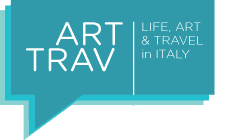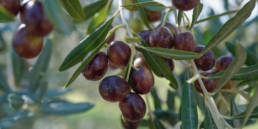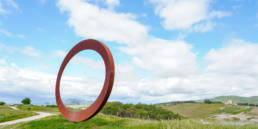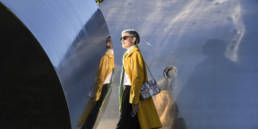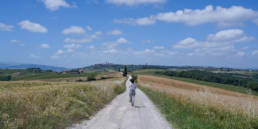A golden spaceship has descended upon Prato, Florence’s industrial and multicultural neighbour. A sort of metal flame pulsates from above, wanting to be a radio signal that both diffuses and receives creative input. I’ve watched it grow up around the old Centro per l’Arte Contemporanea Luigi Pecci since they broke ground in 2009 and I’ve deliberately suspended judgement, both on the architecture and, as it begun to be announced, on the museum’s content. I waited until the crowds dissipated somewhat after the October 16th opening and, 2 weeks later, I’ve been to see the new Pecci in Prato and its inaugural exhibit, The End of the World. It’s worth the trip to Prato.

I’m relieved to say I like the building and I love the show. I remember when the expansion project was presented in 2009 at an important tourism fair in Milan where I was working as an arts blogger for the region of Tuscany (and the design dates to 2006). So while 10 years may be fast building by Italian standards, it’s safe to say that it’s been long enough to generate a lot of anticipation. The plan was for the Pecci to become Tuscany’s contemporary art center, and it would do so by expanding its floor space, allowing it to display its permanent collection as well as the rotating exhibitions that it has always done. The Pecci opened in 1988 and at the time it didn’t have a permanent collection, but works were purchased connected to the exhibits held over the decades, forming a nucleus of about 1000 items by many Italian and some international artists. It was also an archive and research center, and it has put on some cool shows over the years, but I wouldn’t be the first to say that it lacked appeal and visitor numbers. The 14.4 million euro renovation, one hopes, will change that.

The new Pecci is managed by a foundation for the contemporary arts in Tuscany and it takes on missions beyond the traditional ones of collecting, preserving and informing. In light of modern viewers, it declares that it will “adopt a synaesthetic approach, that is to say the contemporary use of all the senses” in the hopes of making contemporary art more accessible to the general public. It is doing so first and foremost by extended opening hours and a great line up of events that should keep us coming back. And second, we’ll see that the curators have taken this mission to heart. In addition, in its central role in Tuscany, the Pecci will give exposure to private contemporary galleries and coordinate public projects like displaying art in spaces outside of the museum or encouraging young artists through contests. The full expression of this mission will come clear, I expect, once the old building reopens and the landscaping around the center is complete.
The End of the World
The new Pecci’s first exhibit is called La Fine del Mondo / The End of the World (until March 17, 2017). It is fantastic for a number of reasons. The theme needs little introduction, and in fact there is none in the gallery (if you live in the area, you couldn’t miss the tons of information on their website, the special issue in The Florentine, the buzz in local papers, and plenty of other sources to tell you what the show is about). But the title says enough. The works in the show are artists’ reflections on this theme – some purpose-made for this space – as well as the curators’ selection of pieces from the permanent collection that are either on the theme or can be made to dialogue with it. That’s how you end up with Björk, Andy Warhol and an unknown prehistoric artist all in one exhibition.

True to its word, the Pecci is immersive, but not in a way that feels uncomfortable or discombobulating. In the first room, the ceiling literally comes down, a tumbling of building materials that make you wonder if after just two weeks the architect’s bravura was proven wrong. There are numerous other moments in the display where you wonder if something is just unfinished. An office is frozen in time (the early 90s) with a grey powder on top of everything that looks awfully like last week’s news, either in war zones or in earthquake zones. Causes of destruction are not indicated here, but they are in the large work on paper by Chinese artist Qiu Zhijie, where his map to navigate the modern world includes sentiments, trends and so much more. All of which may lead to our demise. Or not.

You’re led into the next space and then the wall seems to be unfinished and you think well, so they didn’t really finish building it after all. And then structure starts to disintegrate and the floor changes and the ceiling gets lower and things become wood and you realize you’re inside a work of art that didn’t have a label to warn you where it started. [Walk through this with me: click the video below.]
Then there’s a room with immersive sound and two huge video screens for a music-video-slash-contemporary-emotional-act by Björk commissioned by the MET (Black Lake) where the song is just beautiful and you really do feel like you’re in this post-apocalyptic scene with the artist. She walks, she beats at her heart, she’s in the dark, and at one point she’s in a kind of tunnel that feels a lot like the one you’ve just come out from, where at the end there was a label saying it was by Henrique Oliveira.
Another room seems like an installation of works related to geography in different media, by one artist – but it’s by many artists, brilliantly grouped together.

In the next, there’s a Marcel Duchamp readymade, a prehistoric female figure, a slashed canvas by Fontana and some video screens with some hypnotic project involving cardboard boxes shot just a few months ago.

We move into a space behind a curtain, thinking we might find more video art and we’re pleasantly surprised by a silent, still representation of the city of Havana by night (Carlos Garaioa, 2016) that we can either walk through or see from above from a viewing platform. It’s relaxing and beautiful.

There’s a room where you have the usual “is this really art” feeling, a mish mash of political references and video art that I could have done without. And then two huge spaces given to two final big bang works.
The architecture has gently arched its way back to the beginning, come full circle so to speak, without drawing particular attention to itself, if not through the occasional windows that pierce the walls and look either out on to the city, or back towards the original building of the Pecci.
I posted Cai Guo-Quiang’s “Head On” on social media and it immediately got negative responses, more likely by defenders of animal rights than for the simple yet cleverly executed message it communicates. People find it disturbing. I find it brilliant. 99 reproductions of wolves (not taxidermy!) march swiftly towards a glass wall, into which they spectacularly smash in one gigantic accident… and then trot back to do it all over again. As if to say: “The end of the world? We’re stupid enough to lead ourselves towards it.”
A photo posted by Alexandra Korey (@arttrav) on
Visitori Information
Centro per l’Arte Contemporanea Luigi Pecci
Viale della Repubblica, 277, 59100 Prato PO, ItaliaTickets – adults €10, reduced €7
Open Tuesday to Sunday h. 11.00 AM – 11.00 PMwww.centropecci.it/en
Sign up to receive future blog posts by email
Alexandra Korey
Alexandra Korey aka @arttrav on social media, is a Florence-based writer and digital consultant. Her blog, ArtTrav has been online since 2004.
Related Posts
November 17, 2021
My favourite suppliers of Tuscan olive oil
May 20, 2021
Volterra: Art, Wine and Minerals
January 17, 2021
